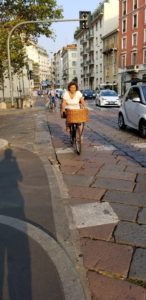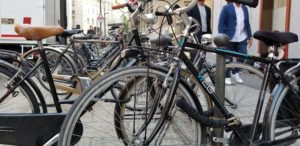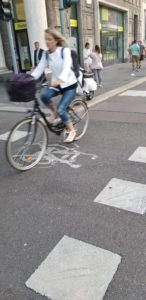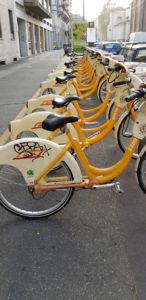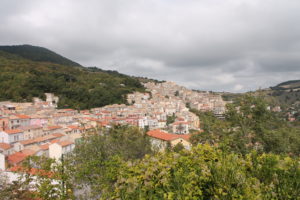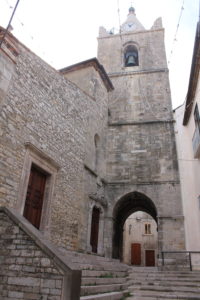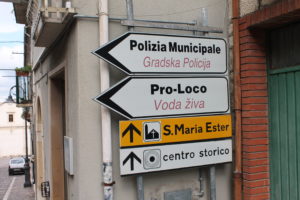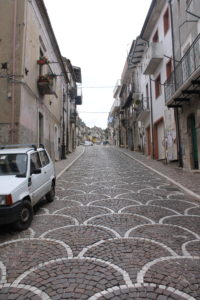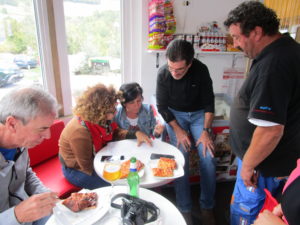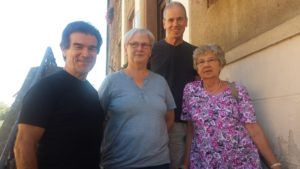For the most part, families are wonderful. They give us support, encouragement and love.
But they also give us their blood and guts.
I’ve spent a lifetime trying to ward off the inevitable, my ancestors’ legacies.
Last month, 50 years of bike riding, running and pretending I’m Arnold Schwarzenegger in the gym failed me. That three grandparents died of heart disease, I was doomed. No outrunning, out-biking or out-lifting that.
Late last year I noticed my blood pressure rising. My cardiologist said when I got back from Colorado, where we spent the holidays with our family, he’d run some tests. But on New Year’s Day, my blood pressure spiked to 201/106. That’s stroke territory. The ER doc in Colorado said I wasn’t having a heart attack, but he couldn’t reduce my BP much below 175. “See your cardiologist,” he said. All that medical training and this is the best advice he can offer?
I did when we returned to Florida. He ordered some tests, the penultimate of which was a cardiac CT scan that takes pictures of the heart arteries. By the time I had it done, we were only six days from leaving for a 3-week vacation in Chile. Two days later, I had a follow-up visit with him, but he had yet to see the test results. “I’ll call you when I get them. Maybe I can text the doc and get a preliminary reading” he said. I walked to the front area and began to check out when he comes down the hall and tells me to come back to the exam room. He shows me the terse response to his text: “Very bad.”
My cardiologist said he could perform a catheterization the next morning. It’s the final arbiter, as they run a camera up through your veins to the heart and get the definitive look. “If I can put some stents in, you can go on your trip,” he said.
But it wasn’t to be. The blockage, which included the LAD artery, nicknamed “the widow maker,” was in areas of the arteries that precluded stents.
He still was willing to entertain the idea of me going to Chile. But when I told him that the first stop was the Atacama High Desert, one of the driest spots on earth at 8,000 feet, he raised his eyebrows. When I told him on the third day we were to start a hike at 15,000 feet, his eyes popped out of his head. Karla and I looked at one another. Just maybe being in a foreign country in the middle of nowhere having a self-induced heart attack was not the best way to spend a vacation.
Two weeks later I met with the surgeon. Folks who knew him said he was good. The nurse in the catheterization lab said he was excellent but “a little gruff.” But then again, he was a surgeon, many of whom have a reputation for bad bedside manners, in part because when they enter a room, they hear trumpets. Which seems to prevent them from hearing their patients’ concerns.
This guy was different. First, he had, in his youth, done the Ironman. He said he used to work out two hours a day. So at least he understood the disorder that some of us have about loving to suffer. He spent an hour with me and assured me that I was a low-risk patient. The only concerning factor was that I was immune compromised, my psoriatic arthritis. Factoring that in, they have a matrix that shows your risk factor. The one that caught my eye was that I had an 8% chance of dying during the surgery.
Eight percent? If I was told I’d get $50 million dollars and I can watch Marjorie Taylor Greene get the Salem witch treatment but had an 8 percent chance of dying immediately afterwards, I think I’d pass. But I decided to roll the dice, in part because doing nothing didn’t seem an attractive alternative.
He said it was to be a triple bypass. The irony here is that as part of my quest to outfox my grandparents (and mother who had bypass surgery at my age) I twice suffered through a ride from Evergreen to Avon, Colorado, a distance of 117 miles while climbing 10,500 feet over three mountain passes. It was called the Triple Bypass. Oh, aren’t they so clever—and in my case, prophetic!
March 20 arrived, and I was greeted by a nurse whose job was to shave me. She did—everywhere. How many places were they going to cut, I thought? The only thing she left me was my close-up for a porno movie.
Eventually, I was rolled into the operating room, as I tried to keep the number 8% out of my head. Six and half hours later, I received the greatest gift ever—I awoke, dazed with tubes coming out of my chest, but I survived.
The first three days were encouraging. My chest didn’t hurt that much. Guys I had talked to said that was the worst part. But they never broke their femur or cracked their pelvis in eight places. I’m practiced at pain.
The only wrinkle was a visit from my surgeon on the third post-op day. While he had an expansive look inside my chest, he noticed an irregular lymph node, so he biopsied it. “You’ve got cancer,” he said. “You’ll probably need chemotherapy.” But it looks like I’ll need nothing—literally. “You’ve probably had this small cell lymphoma for years,” the hematologist said, “And it’s so slow growing that you’ll probably never need treatment.”
By the fourth day, my stomach began talking to me. The next day I was doubled over. Of course, the hospital ordered a scan: Voila! I had gallstones and the whole organ was failing, a not uncommon occurrence after heart surgery. Seems the gallbladder, when teetering on the edge before heart surgery goes over it when you mess with the heart. Kate, the first of our three kids to spend a week with me and Karla, walked me through the darkest period of this whole sordid affair. My Romanian general surgeon said she could take it out that night. So about 7 pm, I’m rolled into the pre-op room. By 10 pm I’m the only one there, except for the nurses waiting for gunshot victims.
I’m wheeled into the operating room and put under general anesthesia for the second time in seven days. When I awoke, I asked how it went. “It didn’t,” she said. “You went into a-fib.” She said she consulted with my heart surgeon. “He said it would probably be OK.”
Probably? He’s sitting at home, probably watching The Housewives of New Jersey, while I was probably going to be OK. I was glad she demurred. “I thought it wise to wait until tomorrow when the hospital is filled with plenty of experts I can call on,” she said. She was being cautious and advised, “There’s a reason patients have better outcomes with female surgeons.”
Why the hell are women so much smarter than us?
So the next day, as she put it, she “stabbed me four times,” inserted the robotics, clipped the gallbladder from the liver, crushed it and sucked it out one of my stab wounds. I was home the next day.
But not for long. Hunter, who had taken over from Kate, and I went for a walk, after which I had a pain in my chest. Consulting the impeccable health source, Google, I learned that fleeting chest pains are common after a bypass. But this one didn’t fleet. Six hours later I was in the ER.
They thought the pains were simply the sternum rearranging itself and complaining after it was assaulted, but of course they ran some tests. They still couldn’t tell me the source of the pain but discovered two blood clots in my lungs, again a typical byproduct of a bypass. I was back in the hospital for couple of days until they decided that the embolisms were safely parked in my lungs and weren’t going anywhere. A six-month course of blood thinners should allow them to dissolve.
This marked the second time in recent years I spent my birthday in the hospital. That could be depressing, but I prefer to consider these trips “destination birthdays.”
The last doc doing rounds that morning was a colleague of my surgeon who had come in almost daily to offer a few words of wisdom and encouragement and then disappear. He looked like Dr. Marcus Welby but older. I had earlier asked him if he was a sort of surgeon emeritus. “No,” he said. “if you don’t operate, you’re out of here.” I later learned that this guy who looked to be well into his 70s, had twin 15-year-old daughters at home. So, even if could, he couldn’t afford to be emeritus.
But on this morning, he tried to lift my spirits. “You know,” he said. “You’ve been through a lot, what with three major things happening to you—the bypass, gallbladder and cancer.”
“Four things,” I said, “You forget why I’m here now—the embolisms.”
“Oh yeah,” he said. “Any one of those could have killed you!”
I’m not sure if he was trying to bolster me, but all I could think of was “Yeah but there’s still time.”
Later that day, I was home again, this time with my son Zack, his wife Chelsie, and my 7-month-old grandson Orion, who so far seems pretty enamored with life. He smiles a lot. Which was good for me.
Daily walks and naps, along with anything I want to eat (because I lost 14 pounds during my ordeals) have been my routine. I feel like I’m making daily progress. I’m a little less tired each day. My walking pace has picked up. And the fatigue I had for the past couple of years has lessened, replaced by a tiredness that I think relates to my physical trauma, understandably so.
I’ve tried to make peace with my ancestors for treating me this way, though years of ice cream piled in what is known in our house as a “Griendling bowl” may not have helped. Grandpop Andrew Griendling had what I’ve essentially got—arteriosclerosis. He died of it at my age. His wife Anna, nee Corvin, was rolled into the operating room for heart surgery, said, “It’s chilly in here” and promptly died. Grandpop Pasquale Petta died at 66 after two heart attacks a week apart. But his legacy included a full head of black hair, for which I’m vain enough to consider it a fair trade.
Ah but, Grandmom Maria, who lived until I was in my 40s, was the exception. I don’t know what she died from officially, but she lived until 90, all the while resigned to life’s imperfections. The glass was always half full.
Some people think because I’ve had this string of broken bones and brains these last four years and am now recovering from surgery that I’m tough or dogged—or too stupid to know the difference. No, I get strength from those around me, and they all were here this past month. What a gift! And after all, whatever I’ve gone through Karla and the kids have had to, also. But they didn’t have the advantage I did—drugs.
The glass is more than half full and then some.


